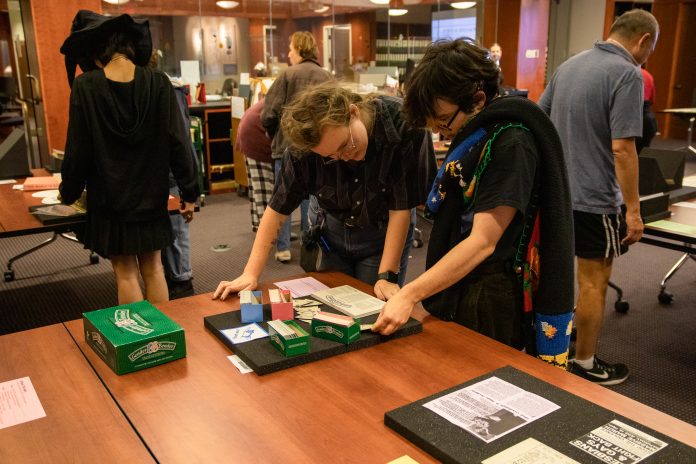Thursday, Oct. 6, Earl Gregg Swem Library’s Special Collections held its first open house since the start of the COVID-19 pandemic in 2020. The event showcased their new collection of American LGBTQ+ legal history, the first of its kind. Everyone was free to examine and personally handle the material that filled the tables, which included everything from petitions to board games.
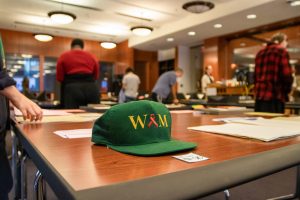
The new archive struck a chord within students, many of whom had never seen anything like it.
“When I was a freshman, Special Collections put on an event like this, and it was incredible, but I wasn’t able to go, and then the pandemic happened,” Rainbow Coalition co-President Aubrey Lay ’23 said. “Nothing like this has really happened since, so it’s been really exciting to bring it back.”
Lay also described the rich texture that in-person viewing brings to discussions of the archives.
“It’s really great to see more about the queer history of campus, because as much as I try to learn as much as I can by talking to folks who I know were really heavily involved with the queer community on campus like Professor George Greenia, seeing all this stuff here in person, there’s a whole other story,” Lay added.
Many other students in attendance were members of the Lambda Alliance, another LGBTQ+ student organization, who came to the open house in place of their regular meeting. One member, Kate Jones ’24, expressed awe at a lesbian Sleeping Beauty retelling.
“I thought about how much it would’ve meant to me, to see queer fairy tales as a kid,” Jones said.
Jones further expanded on the meaningfulness of having the College’s LGBTQ+ history archived, especially for queer students.
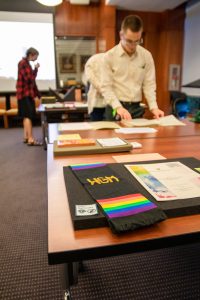
“I feel like people like to say queerness is a trend,” Jones said. “You shouldn’t need to prove it, but being able to have physical copies of all of the work that queer people have been doing for decades to centuries, it’s really awesome. It’s great for queer students to be able to learn about the history of Lambda Alliance and how long it’s been here, and to see solidarity of alumni and of students in the past.”
Other students also echoed the importance of the increased visibility of LGBTQ+ history that the archive brings.
“The evolution of queer interest groups on campus has been really interesting,” attendee Issac Askin ’25 said. “I’ve been looking at a lot of flyers from Alternative, which is the old interest group, like gay students in the eighties and nineties is really nineties grunge core, and it’s like wow, this is really fun to look at.”
Beyond interest in the material, Askin also noted the significance of the archive.
“I feel like a lot of people have a perception that gay people just appeared 10 years ago when gay marriage got legalized, which is obviously not true,” Askin said. “So I think just having what paper history we do have visible is very important to reminding people of that.”
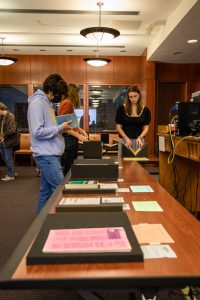
Marian and Alan McLeod Director of Special Collections Jay Gaidmore further elaborated upon Askin’s sentiment.
“I’ve always said that we have the white, cisgender male perspective covered, and we’ll continue collecting that perspective, but there’s other marginalized communities that we need to start documenting because they’ve always been part of society,” Gaidmore said. “They’ve been not only marginalized in the public sphere, but in the archival world as well.”
Gaidmore further explained that this method of gaining marginalized communities’ perspectives through the collection of physical materials provides hands-on interaction with the information — a unique experience not provided by museums or exhibits.
“I think a lot of people think that archives are not supposed to be touched. ‘You need to wear gloves!’ but it’s not true,” Gaidmore said. “We put stuff out, we want you to handle them.”
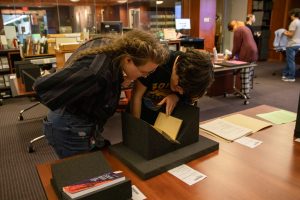
These open houses enable students to interact with all this material and see everything that Special Collections has to offer, in hopes of more students, from any major or grade, utilizing this valuable resource that is accessible to all.
“My goal is to have anybody who graduates from William and Mary never say, ‘Oh, I’ve never been into Special Collections,’” Gaidmore said.
Gaidmore further described the diligent work that Special Collections has been conducting to expand their archives to represent more groups and peoples.
“We’re making a concerted effort to diversify holdings and to make up for lost time on things that should have been collected for years,” Gaidmore said. “We’re just trying to change that and show that the Special Collections is for everybody and that we represent society and culture.”
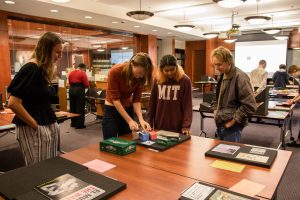
Gaidmore also noted that one struggle in gaining material for archives is the misconception of everyday items being unimportant, when in reality it is these items that archivists seek out the most.
“A lot of the materials that students were accumulating, they may think it’s very ephemeral, something like a flyer they put on or a brochure they passed out at a march,” Gaidmore said. “So they just take that stuff, and they’re like, ‘Oh, I don’t need that anymore,’ and they just throw it away, but we want to collect it…“Without the students, there wouldn’t be a William and Mary.”
Anyone who thinks they might have material to contribute, no matter how seemingly insignificant, can contact Special Collections staff who are excited to work with any student or organization. They can be reached by email at spcoll@wm.edu or by phone at (757) 221-3090.

